
 |

|
"I was certainly not more than six or seven years old when I began to feel myself drawn by Matter - or, more correctly, by something which 'shone' at the heart of Matter." ╣
Thus Teilhard de Chardin, the great Jesuit scientist and seer, and you can recognise the same spirit in the mosaic artist Vanessa Benson. Teilhard was in love with matter, especially in the form of rock, and so is she. Seeing her moving round her studio getting excited about the colours and textures and veins in various chunks of marble makes you think afresh about the real nature of matter, and about mosaics made of stone. Classically defined a mosaic is an image made up of small neutral chunks of hard material. We enjoy the material of which the image is made, but in the end it's the image that counts. After ten minutes with Vanessa, however, you realise that for her a small piece of marble or a hewn pebble can itself be an image that counts. So her "fine art" mosaics, the ones she makes for her own satisfaction, often feature a careful selection of such single images, idiosyncratic pieces of cut stone, set in high relief against a flat "neutral" mosaic background.
But that's not all. These mosaics are more than geological specimen trays. For having found thought-provoking chunks of rock Vanessa then looks for a relationship between the material and the world at large. For example, she once beachcombed a few pebbles, managed to split them open with a hammer and hardie (beach pebbles tend to be extremely tough) and found that the two faces had an intriguing mirror pattern. She pondered her pebble halves, enjoying them per se and as x-rays of the heart of the stone, but also wondering how to use them. Then one day she found herself in the Natural History Museum looking at a map illustrating the distribution of butterflies in Europe, and there was the connection. The split pebbles became butterflies.
Or again, Vanessa likes food. And slicing marble. So we get On The Table, a nouvelle cuisine mosaic where slices of marble become slices of iced cake. Or Tender, Assembled, As Tightly As Possible, where various stones become mouth-watering kebabs. Vanessa remarks of this last, "the more real, the more false". The more the mosaic looks like food, the more of a lie it becomes. A pleasing paradox. She'd love to do a "school dinner" mosaic and watch the reaction. Or again, she was once fascinated by a tv documentary about climate, and then looking a contact sheet of photographs inspired her to make a "contact sheet mosaic" of a tornado growing and moving. She used a series of variously veined "35 mill." marble tesserae as snaps of the storm in action. The idea was to recreate movement in static stone, the movement that the marble originally had; it was born in metamorphic violence and was eventually metamorphosed by the artist into a mosaic embodying a different kind of violence. And Tornado offers more - the flat contact sheet has become a three-dimensional piece; Vanessa relishes the physical depth mosaic offers, the chance to juxtapose different layers of different materials, where the colour and the material are identical, as compared to oil paintings, thin skins of concocted colour on flat canvas.
Vanessa is in fact a painter as well as a mosaicist; the kebab piece is actually one of series of 14-inch square works about food, ten of which (so far) are oils. My favourite of these was Homemade Craters, an explosive combination of red, yellow and black which as you enter the studio looks like a NASA close-up of a bad-tempered Saturnine moon, but turns out to be passion fruit fougasse. Scrumptious and surprising to me, because I had only previously seen Vanessa's stone mosaics, using rather gentle colours. Manifestly she is by no means afraid of bold colour, and is a smalti fan to boot, and of course uses vitreous and ceramic when she needs to - in commissioned work, and so forth. (Incidentally we are both fervent admirers of Colour and Culture by John Gage, Thames & Hudson 1993 hb,1995 pb, the classic study of the history of colour). So how did Vanessa become a mosaic artist? Back in the seventies she studied at Wimbledon and Camberwell Schools of Art, painted for a while, and in due course went to live in a little village in Tuscany, as you do. Nearby was Pietrasanta ("Holystone".), a town where sculpture loomed large, along with mosaic, or so she was told. In fact there was no mosaic there, but somehow the word itself, the idea alone, effected a Damascene conversion - she had to make mosaic. Off she went to CISIM at Ravenna for a month, and learned how to make copies of mosaics using the double reverse method. She still uses this method when she wants to try out combinations of tesserae - the first-stage clay or lime putty base makes experiments easy.
Being basically a big-city lady she next went to Rome to learn more. There were no courses, alas, so she studied fresco and how to restore tempera ceilings instead. But then the Vatican mosaic workshop put her in touch with two practising mosaicists. Paula Frasquarelli made micromosaics - apparently the street leading to St. Peter's is to this day lined with tourist shops selling modern micromosaics - and also normal mosaics in stone and smalti. She took on Vanessa as an apprentice for six months, working on a church mural, direct method into sand and cement and lime putty, this last making the mix workable for longer. Excellent training. Vanessa still frequently uses the same mix, with marble dust - it's like sticking tesserae into butter, she says, and it's easy to get tesserae tight if you want to. After her six months' apprenticeship she went to study with Nello della Ciana, another highly skilled mosaicist, who taught her the indirect method. After eight years in Italy Vanessa decided to go back to London. Mosaic in Rome, at that time anyway, was steeped in tradition and mainly religious, whereas she wanted to do her own thing artistically. Nello disapproved - mosaic is a craft, he maintained, and you do what you are told. She disagreed, and bade au revoir to her favourite mosaic, the "unswept floor" in the Vatican. Back in London she started teaching, which left her free to pursue her own work and also to pass on commissions she didn't fancy. Teaching is still important to her: she gives courses at the City Lit, Holborn, the Working Men's College, Camden Town, and Hampstead School of Art. She hopes to start a course in mural mosaics, perhaps at City Lit (please contact her if interested). Indeed, "public" mosaics interest her more and more. Since her return she feels she has developed significantly. It took her some time to work out a relationship with her mosaic materials, so at first painting was more personal, mosaic more craft. But now she's equally happy with either, and uses mosaic when she knows that it is the perfect medium for whatever idea she has to express. There has to be a relationship between content and material. Above all, she needs to feel she is bringing something new to mosaic - she hasn't much time for sub-Gaudi sticking broken china on pots, for instance.
Having said which, I left her mulling over the possibilities of some ancient beachcombed broken china. The fine cracks in the porcelain had a family resemblance to cracks in some abandoned plastic leaning on the wall opposite. But the result won't end up below a hydrangea, that's for sure. Paul Bentley, Autumn 1999 Vanessa Benson is at 16 St. Peter's Street, London N1 8JG, phone (020) 7226 6875. ╣ Pierre Teilhard de Chardin, The Heart of Matter, trans. RenÚ Hague, Collins 1978, p.17 |
|||||||||
All
content is copyright of © Mosaic Matters and its contributors.
All rights reserved
Mosaic
Matters is:
Editor: Paul Bentley
Web Manager/Designer: Andy Mitchell

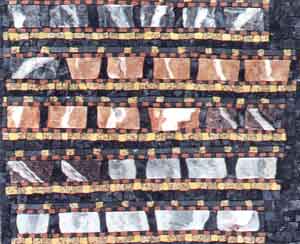
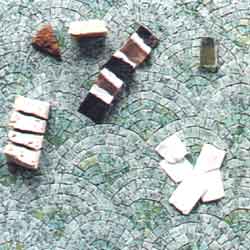
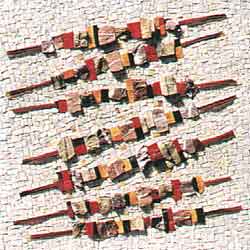
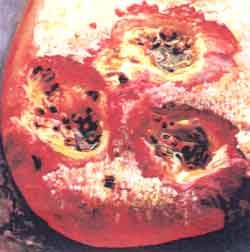
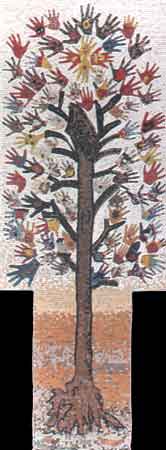
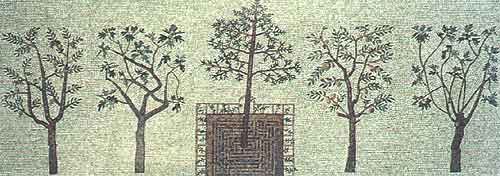 Trees,
marble,200 x 70cm, 1995
Trees,
marble,200 x 70cm, 1995